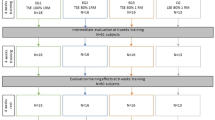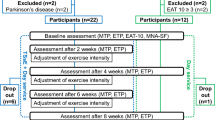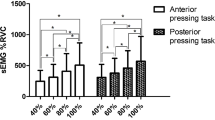Abstract
This pilot study investigated the tongue pull-back (TPB) exercise to improve tongue-base retraction as well as two methods to add resistance to the TPB. Surface electromyography (sEMG) to the submental triangle was used as an indication of tongue-base activity on 13 healthy adults during: (1) saliva swallow, (2) 15 mL water swallow, (3) effortful swallow, (4) unassisted TPB, (5) TPB with added resistance by holding the tongue with gauze (finger-resisted TPB), and (6) TPB with the tongue clipped to a spring-loaded tension resistance device (device-resisted TPB). Order of the exercises was randomized. The exercises fell into two groups—weak and intense. Weak exercises included saliva swallow, water swallow, and unassisted TPB (mean sEMG = 19.07 μV, p = .593). Intense exercises included effortful swallow, finger-resisted TPB, and device-resisted TPB (mean sEMG = 36.44 μV, p = .315). Each intense exercise resulted in significantly higher mean sEMG peak amplitude than each weak exercise (p < .05), with one exception; the effortful swallow was not significantly different than the unassisted TPB (p = .171). This study provides preliminary evidence that the unassisted TPB may not be any more helpful for improving tongue-base retraction than normal swallowing. Adding resistance to the TPB by holding the tongue with gauze may be an effective alternative. This study also demonstrates proof-of-concept for creating a device to attach to the tongue and provide tension resistance during the TPB exercise. Further research with a more sophisticated design is needed before such a device can be fully developed and implemented clinically.



Similar content being viewed by others
Notes
sEMG activity output to a computer was not purchased with the sEMG unit and so was not available for this pilot study.
Clinical experience indicated that individuals tend to curl the tip of the tongue when asked to pull the tongue back, rather than bunching the back of the tongue up in the back of the mouth, which is the proper way to do the TPB.
References
Dodds WJ, Stewart ET, Logemann JA. Physiology and radiology of the normal oral and pharyngeal phases of swallowing. Am J Rehabil. 1990;154:963.
Matsuo K, Palmer JB. Anatomy and physiology of feeding and swallowing—normal and abnormal. Phys Med Rehabil Clin N Am. 2008;19(4):691–707.
Kahrilas P, Logemann J, Lin S, Ergun G. Pharyngeal clearance during swallowing: a combined manometric and videofluoroscopic study. Gastroenterology. 1992;103(1):128–36.
Donner M, Bosma J, Robertson D. Anatomy and physiology of the pharynx. Gastrointest Radiol. 1985;10:196–212.
McConnel FM. Analysis of pressure generation and bolus transit during pharyngeal swallowing. Laryngoscope. 1988;98(1):78.
Kahrilas P. Pharyngeal structure and function. Dysphagia. 1993;8:303–7.
Pouderoux P, Kahrilas P. Deglutitive tongue force modulation by volition, volume, and viscosity in humans. Gastroenterology. 1995;108(5):1418–26.
Lazarus C. Management of swallowing disorders in head and neck cancer patients: optimal patterns of care. Semin Speech Lang. 2000;21(4):309.
Dejaeger E, Pelemans W, Ponette E, Joosten E. Mechanisms involved in postdeglutition retention in the elderly. Dysphagia. 1997;12(2):63–7.
Cola MG, Daniels SK, Corey DM, Lemen LC, Romero M, Foundas AL. Relevance of subcortical stroke in dysphagia. Stroke. 2010;41(3):486.
Eisbruch A, Lyden T, Bradford CR, Dawson LA, Haxer MJ, Miller AE, et al. Objective assessment of swallowing dysfunction and aspiration after radiation concurrent with chemotherapy for head-and-neck cancer. Int J Radiat Oncol. 2002;53(1):28.
Logemann J. Evaluation and treatment of swallowing disorders, chapter 3. Anatomy and physiology of normal deglutition. 3rd ed. Austin: Pro-Ed; 1998. p. 33.
Miller A. Neurophysiological basis of swallowing. Dysphagia. 1986;1:91–100.
Corbin-Lewis K, Liss J, Sciortino K. Clinical anatomy and physiology of the swallow mechanism, chapter 2. Examination of the pharyngeal swallow component. Clifton Park: Thomas Delmar Learning; 2004. p. 60.
Seikel J, King W, Drumright D. Anatomy & physiology for speech, language, and hearing, chapter 8. Physiology of mastication and deglutition. 4th ed. Clifton Park: Cengage Learning; 2010. p. 414.
Napadow V, Chen Q, Wedeen V, Gilbert R. Biomechanical basis for lingual muscular deformation during swallowing. Am J Physiol Gastrointest Liver Physiol. 1999;277(3):G701.
Groher M, Crary M. Dysphagia: Clinical management in adults and children, Chapter 2. Normal swallowing in adults. Maryland Heights: Mosby, Inc; 2010. p. 27.
Palmer P, Luschei E, Jaffe D, McCulloch T. Contributions of individual muscles to the submental surface electromyogram during swallowing. JSLHR. 1999;42(6):1378–91.
Lazarus C, Logemann J, Wook Song C, Rademaker A, Kahrilas P. Effects of voluntary maneuvers on tongue base function for swallowing. Folia Phoniatr Logop. 2002;54(4):171–6.
Hind JA, Nicosia MA, Roecker EB, Carnes ML, Robbins J. Comparison of effortful and noneffortful swallows in healthy middle-aged and older adults. Arch Phys Med Rehabil. 2001;82(12):1661–5.
Huckabee M, Steele CM. An analysis of lingual contribution to submental surface electromyographic measures and pharyngeal pressure during effortful swallow. Arch Phys Med Rehabil. 2006;87(8):1067–72.
Huckabee M, Butler SG, Barclay M, Jit S. Submental surface electromyographic measurement and pharyngeal pressures during normal and effortful swallowing. Arch Phys Med Rehabil. 2005;86(11):2144–9.
Veis S, Logemann JA, Colangelo L. Effects of three techniques on maximum posterior movement of the tongue base. Dysphagia. 2000;15(3):142–5.
Johnson D, Herring H, Daniels S. Dysphagia management in stroke rehabilitation. Curr Phys Med Rehabil Rep. 2014;2(4):218.
Murry T, Carrau R. Clinical management of swallowing disorders. 2nd ed. San Diego: Plural Publishing; 2006.
Steele CM, Huckabee ML. The influence of orolingual pressure on the timing of pharyngeal pressure events. Dysphagia. 2007;22(1):36.
Park J, Oh J, Park S, Yoon T, Kwon B. Effortful swallowing training coupled with electrical stimulation leads to an increase in hyoid elevation during swallowing. Dyshpagia. 2009;24:296–301.
Park J, Kim Y, Oh J, Lee H. Effortful swallowing training combined with electrical stimulation in post-stroke dysphagia: a randomized controlled study. Dysphagia. 2012;27:521–7.
Clark MC, Shelton N. Training effects of the effortful swallow under three exercise conditions. Dysphagia. 2014;29:553–63.
Robbins J, Butler SG, Daniels S, Gross RD, Langmore S, Lazarus C. Swallowing and dysphagia rehabilitation: translating principles of neural plasticity into clinically oriented evidence. JSLHR. 2008;51(1):300.
Burkhead LM, Sapienza CM, Rosenbek JC. Strength-training exercise in dysphagia rehabilitation: principles, procedures, and directions for future research. Dysphagia. 2007;22(3):251–65.
Kleim JA, Jones TA. Principles of experience-dependent neural plasticity: implications for rehabilitation after brain damage. J Speech Lang Hear Res. 2008;51(1):225–39.
Hamdy S, Aziz Q, Rothwell JC, Power M, Singh KD, Nicholson DA, et al. Recovery of swallowing after dysphagic stroke relates to functional reorganization in the intact motor cortex. Gastroenterology. 1998;115(5):1112.
Kim J, Sapienza C. Implications of expiratory muscle strength training for rehabilitation of the elderly: tutorial. J Rehabil Res Dev. 2005;42(2):211–24.
Troche M, Okun M, Rosenbek J, Musson N, Fernandez H, Rodriguez R, et al. Aspiration and swallowing in Parkinson disease and rehabilitation with EMST. Neurology. 2010;75(21):1912–9.
Miller J, Watkin K. The influence of bolus volume and viscosity on anterior lingual force during the oral stage of swallowing. Dysphagia. 1996;11(2):117–24.
Huckabee M, Low IS, McAuliffe MJ. Variability in clinical surface electromyography recording of submental muscle activity in swallowing of healthy participants. Asia Pac J Speech Lang Hear. 2012;15(3):186.
Crary M, Groher M. Basic concepts of surface electromyographic biofeedback in the treatment of dysphagia: a tutorial. Am J Speech Lang Pathol. 2000;9(2):125.
Bryant M. Biofeedback in the treatment of a selected dysphagic patient. Dysphagia. 1991;6(3):140–4.
Author information
Authors and Affiliations
Corresponding author
Rights and permissions
About this article
Cite this article
Slovarp, L., King, L., Off, C. et al. A Pilot Study of the Tongue Pull-Back Exercise for Improving Tongue-Base Retraction and Two Novel Methods to Add Resistance to the Tongue Pull-Back. Dysphagia 31, 416–423 (2016). https://doi.org/10.1007/s00455-016-9693-y
Received:
Accepted:
Published:
Issue Date:
DOI: https://doi.org/10.1007/s00455-016-9693-y




